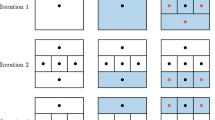Abstract
Positive bases, which play a key role in understanding derivative free optimization methods that use a direct search framework, are positive spanning sets that are positively linearly independent. The cardinality of a positive basis in \(\mathbb {R}^n\) has been established to be between \(n+1\) and 2n (with both extremes existing). The lower bound is immediate from being a positive spanning set, while the upper bound uses both positive spanning and positively linearly independent. In this note, we provide details proving that a positively linearly independent set in \(\mathbb {R}^n\) for \(n \in \{1, 2\}\) has at most 2n elements, but a positively linearly independent set in \(\mathbb {R}^n\) for \(n\ge 3\) can have an arbitrary number of elements.
Similar content being viewed by others
References
Audet, C., Dennis, J.: Mesh adaptive direct search algorithms for constrained optimization. SIAM J. Optim. 17, 2006 (2004)
Audet, C.: A short proof on the cardinality of maximal positive bases. Optim. Lett. 5(1), 191–194 (2011)
Coope, I.D., Price, C.J.: Positive bases in numerical optimization. Comput. Optim. Appl. 21(2), 169–175 (2002)
Davis, C.: Theory of positive linear dependence. Am. J. Math. 76, 733–746 (1954)
Kolda, T.G., Lewis, R.M., Torczon, V.: Optimization by direct search: new perspectives on some classical and modern methods. SIAM Rev. 45(3), 385–482 (2003)
Lewis, R.M., Torczon, V.: Rank ordering and positive bases in pattern search algorithms. Technical Report, Institute for Computer Applications in Science and Engineering (ICASE) (1996)
Rockafellar, R.T., Wets, R.J.-B.: Variational Analysis. Grundlehren der Mathematischen Wissenschaften [Fundamental Principles of Mathematical Sciences], vol. 317. Springer, Berlin (1998). (Corrected 3rd printing 2009)
Regis, R.G.: On the properties of positive spanning sets and positive bases. Optimization and Engineering (2015). http://link.springer.com/article/10.1007/s11081-015-9286-x. (online first)
Shephard, G.C.: Diagrams for positive bases. J. London Math. Soc. 2(4), 165–175 (1971)
Acknowledgments
This research was partially funded by the Natural Sciences and Engineering Research Council (NSERC) of Canada, Discover Grant #355571-2013, and by the Pacific Institute for the Mathematical Sciences (PIMS), “Optimization: Theory, Algorithms, and Applications” Collaborative Research Group. The authors are indebted to Dr. C. Audet, for helpful feedback and providing the new (shorter) proof to Proposition 3 which is presented in this paper.
Author information
Authors and Affiliations
Corresponding author
Rights and permissions
About this article
Cite this article
Hare, W., Song, H. On the cardinality of positively linearly independent sets. Optim Lett 10, 649–654 (2016). https://doi.org/10.1007/s11590-015-0959-3
Received:
Accepted:
Published:
Issue Date:
DOI: https://doi.org/10.1007/s11590-015-0959-3




